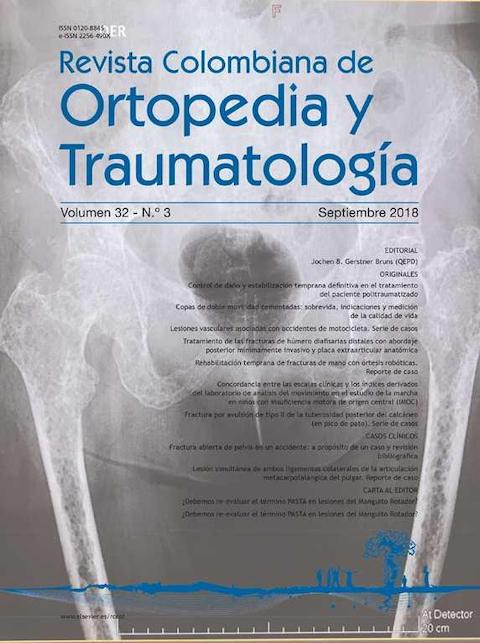Control de daño y estabilización temprana definitiva en el tratamiento del paciente politraumatizado
DOI:
https://doi.org/10.1016/j.rccot.2017.11.009Palabras clave:
politraumatismo, ortopedia, tratamiento quirúrgico, índice de gravedad del traumatismoResumen
Introducción: En este estudio se busca evaluar los desenlaces de los pacientes con traumatismo múltiple, fractura de pelvis o de huesos largos, que recibieron tratamiento con estabilización definitiva de sus fracturas en las primeras 48 horas y después de 48 horas del episodio traumático.
Materiales y métodos: Estudio de tipo cohorte retrospectiva que incluye a todos los pacientes politraumatizados con fracturas de pelvis o de huesos largos, que ingresaron en una institución de salud de nivel IV entre enero de 2012 y junio de 2016. Se evaluaron mortalidad, infección, tiempo de hospitalización y complicaciones. Además, se calculó el índice de gravedad del traumatismo (ISS) y el nuevo índice (NISS) de cada paciente.
Resultados: Ingresaron 220 pacientes, con predominio masculino (82%). La nueva escala del índice de gravedad del traumatismo (NISS) registró una mediana 4,5 puntos mayor a la mediana de la escala de ISS tradicional (34 frente a 29,5; p = 0,016). Los pacientes con fijación temprana definitiva tuvieron menor tiempo de hospitalización (p = 0,008) y menos complicaciones (p = 0,022).
Discusión: La escala tradicional del ISS podría subestimar la gravedad del traumatismo en los pacientes politraumatizados al no permitir que un mismo sistema registre más de una afectación independiente de cuán comprometido haya estado. El control del daño se puede reservar para los pacientes más graves, que no se compensan tras la reanimación inicial, con valores de ISS y NISS por encima de 36 y 40 puntos, respectivamente.
Nivel de evidencia clínica Nivel: II.
Descargas
Referencias bibliográficas
Pape HC, Giannoudis PV, Krettek C, Trentz O. Timing of fixation of major fractures in blunt polytrauma: role of conventional indicators in clinical decision making. J Orthop Trauma. 2005;19:551-62. https://doi.org/10.1097/01.bot.0000161712.87129.80
D'Alleyrand JC, O'Toole RV. The evolution of damage control orthopedics: current evidence and practical applications of early appropriate care. Orthop Clin North Am. 2013;44:499-507. https://doi.org/10.1016/j.ocl.2013.06.004
Vallier HA, Wang X, Moore TA, Wilber JH, Como JJ. Timing of orthopaedic surgery in multiple trauma patients: development of a protocol for early appropriate care. J Orthop Trauma. 2013;27:543-51. https://doi.org/10.1097/BOT.0b013e31829efda1
Roberts CS, Pape HC, Jones AL, Malkani AL, Rodriguez JL, Giannoudis PV. Damage control orthopaedics: evolving concepts in the treatment of patients who have sustained orthopaedic trauma. Instr Course Lect. 2005;54:447-62. https://doi.org/10.2106/00004623-200502000-00030
Vallier HA, Super DM, Moore TA, Wilber JH. Do patients with multiple system injury benefit from early fixation of unstable axial fractures? The effects of timing of surgery on initial hospital course. J Orthop Trauma. 2013;27:405-12. https://doi.org/10.1097/BOT.0b013e3182820eba
Nahm NJ, Vallier HA. Timing of definitive treatment of femoral shaft fractures in patients with multiple injuries: a systematic review ofrandomized and nonrandomized trials. J Trauma Acute Care Surg. 2012;73:1046-63. https://doi.org/10.1097/TA.0b013e3182701ded
Martínez A. Control del dano˜ en ortopedia y traumatología. Rev Col Or Tra. 2006;20:55-64.
Barei DP, Shafer BL, Beingessner DM, Gardner MJ, Nork SE, Routt ML. The impact of open reduction internal fixation on acute pain management in unstable pelvic ring injuries. J Trauma. 2010;68:949-53. https://doi.org/10.1097/TA.0b013e3181af69be
White TO, Jenkins PJ, Smith RD, Cartlidge CW, Robinson CM. The epidemiology of posttraumatic adult respiratory distress syndrome. J Bone Joint Surg Am. 2004;86-A:2366-76. https://doi.org/10.2106/00004623-200411000-00002
Harwood PJ, Giannoudis PV, Probst C, Krettek C, Pape HC. The risk of local infective complications after damage control procedures for femoral shaft fracture. J Orthop Trauma. 2006;20:181-9. https://doi.org/10.1097/00005131-200603000-00004
Lefaivre KA, Starr AJ, Stahel PF, Elliott AC, Smith WR. Prediction of pulmonary morbidity and mortality in patients with femur fracture. J Trauma. 2010;69:1527-35. https://doi.org/10.1097/TA.0b013e3181f8fa3b
Pape HC, Rixen D, Morley J, Husebye EE, Mueller M, Dumont C, et al., EPOFF Study Group. Impact of the method of initial stabilization for femoral shaft fractures in patients with multiple injuries at risk for complications (borderline patients). Ann Surg. 2007;246:491-9. https://doi.org/10.1097/SLA.0b013e3181485750
Pape HC, Regel G, Dwenger A, Sturm JA, Tscherne H. Influence of thoracic trauma and primary femoral intramedullary nailing on the incidence of ARDS in multiple trauma patients. Injury. 1993;24 Supl 3:S82-103. https://doi.org/10.1016/0020-1383(93)90012-U
Hildebrand F, van Griensven M, Huber-Lang M, Flohe SB, Andruszkow H, Marzi I, et al. Is there an impact of concomitant injuries and timing of fixation of major fractures on fracture healing? A focused review of clinical and experimental evidence. J Orthop Trauma. 2016;30:104-12. https://doi.org/10.1097/BOT.0000000000000489
Balogh ZJ, Reumann MK, Gruen RL, Mayer-Kuckuk P, Schuetz MA, Harris IA, et al. Advances and future directions for management of trauma patients with musculoskeletal injuries. Lancet. 2012;380:1109-19. https://doi.org/10.1016/S0140-6736(12)60991-X
Baker SP, O'Neill B. The injury severity score: an update. J Trauma. 1976;16:882-5. https://doi.org/10.1097/00005373-197611000-00006
Wong TH, Krishnaswamy G, Nadkarni NV, Nguyen HV, Lim GH, Bautista DC, et al. Combining the new injury severity score with an anatomical polytrauma injury variable predicts mortality better than the new injury severity score and the injury severity score: a retrospective cohort study. Scand J Trauma Resusc Emerg Med. 2016;24:25. https://doi.org/10.1186/s13049-016-0215-6
Deng Q, Tang B, Xue C, Liu Y, Liu X, Lv Y, et al. Comparison of the ability to predict mortality between the injury severity score and the new injury severity score: A metaanalysis. Int J Environ Res Public Health. 2016;13(8.):E825, https://doi.org/10.3390/ijerph13080825
Rapsang AG, Shyam DC. Scoring systems of severity in patients with multiple trauma. Cir Esp. 2015;93:213-21. https://doi.org/10.1016/j.cireng.2013.12.031
Osler T, Baker SP, Long W. A modification of the injury severity score that both improves accuracy and simplifies scoring. J Trauma. 1997;43:922-5. https://doi.org/10.1097/00005373-199712000-00009
Pape HC, Lefering R, Butcher N, Peitzman A, Leenen L, Marzi I, et al. The Definition of polytrauma revisited: An international consensus process and proposal of the new 'Berlin definition'. J Trauma Acute Care Surg. 2014;77: 780-6. https://doi.org/10.1097/TA.0000000000000453
Metsemakers WJ, Handojo K, Reynders P, Sermon A, Vanderschot P, Nijs S. Individual risk factors for deep infection and compromised fracture healing after intramedullary nailing of tibial . shaft fractures: a single centre experience of 480 patients. Injury. 2015;46:740-5. https://doi.org/10.1016/j.injury.2014.12.018
Crist BD, Ferguson T, Murtha YM, Lee MA. Surgical timing of treating injured extremities: an evolving concept of urgency. Instr Course Lect. 2013;62:17-28.
Illescas Fernandez GJ. Escalas e índices de severidad en trauma. Trauma. 2003;6:88-94.
Bone LB, Giannoudis P. Femoral shaft fracture fixation and chest injury after polytrauma. J Bone Joint Surg Am. 2011;93:311-7. https://doi.org/10.2106/JBJS.J.00334
Johnson KD, Cadambi A, Seibert GB. Incidence of adult respiratory distress syndrome in patients with multiple musculoskeletal injuries: effect of early operative stabilization of fractures. J Trauma. 1985;25:375-84. https://doi.org/10.1097/00005373-198505000-00001
Gandhi RR, Overton TL, Haut ER, Lau B, Vallier HA, Rohs T, et al. Optimal timing of femur fracture stabilization in polytrauma patients: A practice management guideline from the Eastern Association for the Surgery of Trauma. J Trauma Acute Care Surg. 2014;77:787-95. https://doi.org/10.1097/TA.0000000000000434









